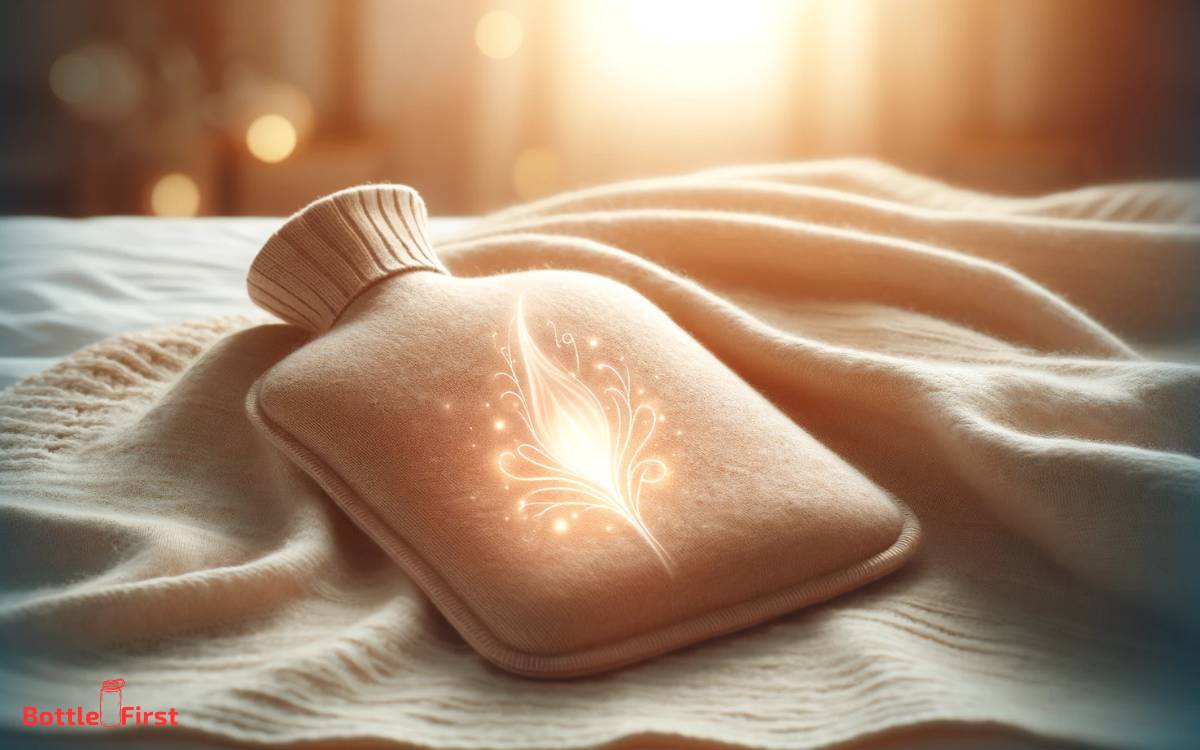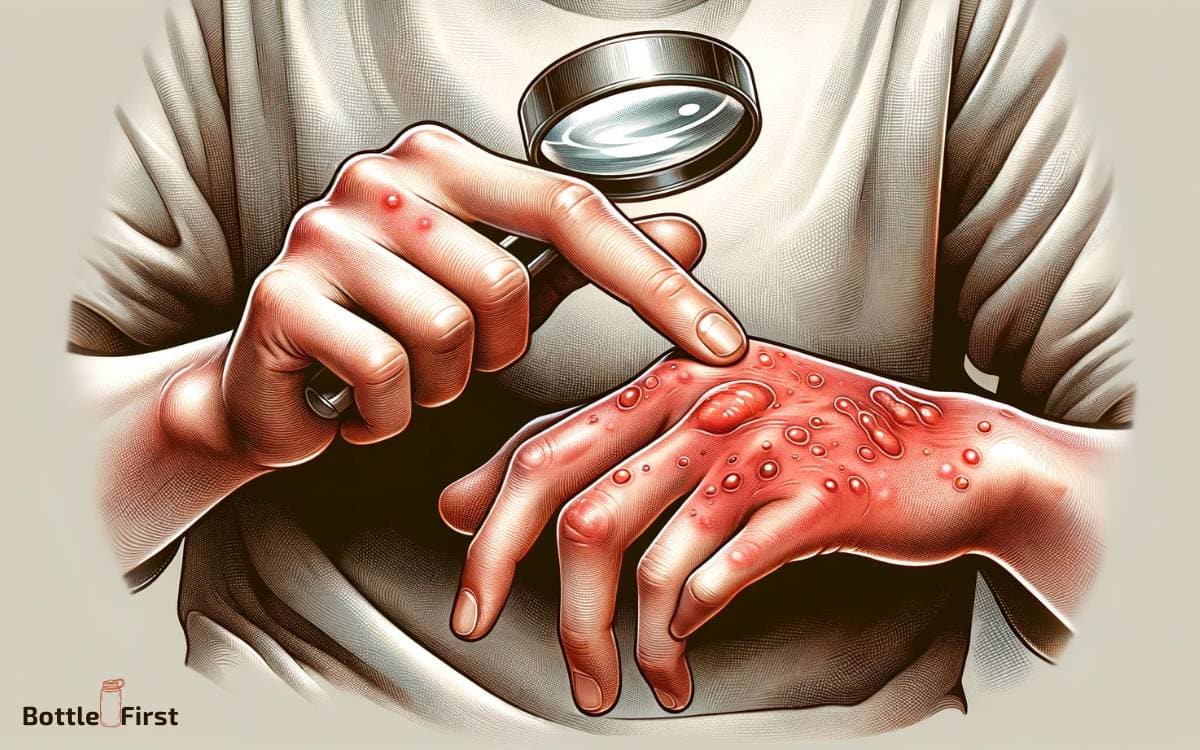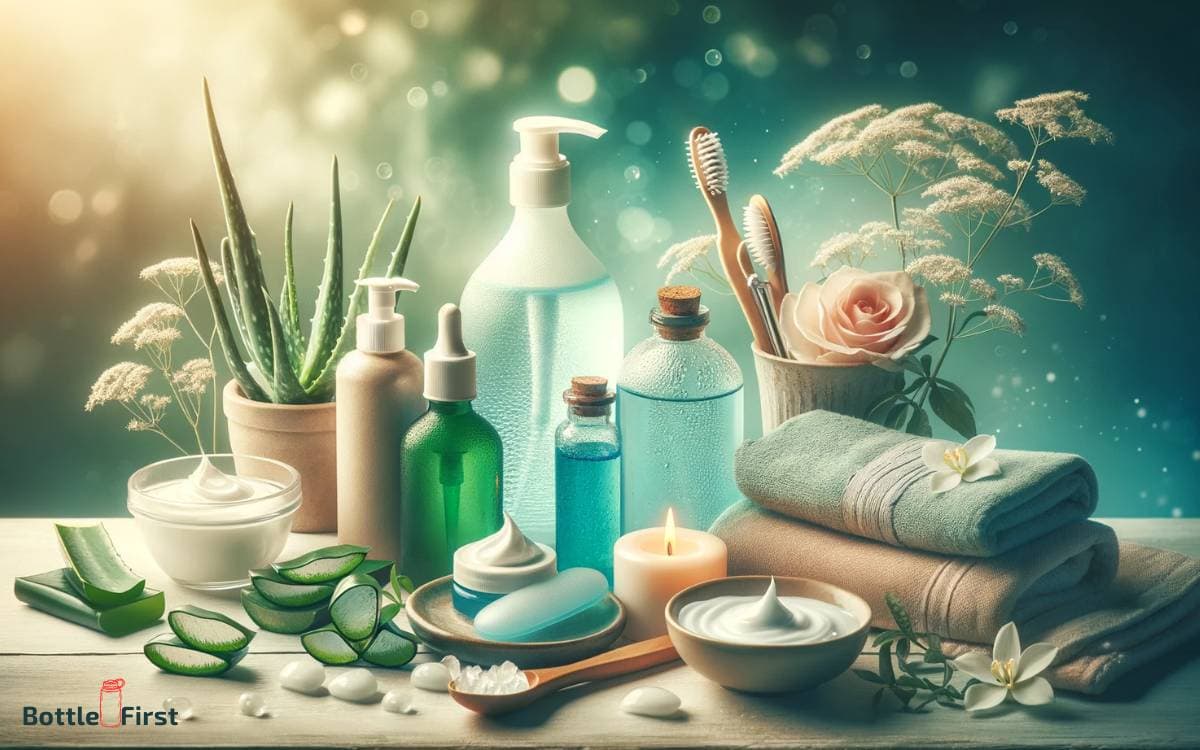How to Treat Hot Water Bottle Rash? 4 Easy Steps!
Treating hot water bottle rash involves several steps. Begin by cooling the area with a cold compress, then apply a gentle moisturizer or aloe vera to soothe the skin.
If the rash persists, consider using over-the-counter steroid creams or antihistamines to reduce inflammation and itching.
Always avoid scratching the area to prevent the condition from worsening. Consult with a healthcare professional if symptoms persist.
Hot water bottle rash is a skin irritation caused by prolonged exposure to heat from a hot water bottle. The heat can cause the skin to become dry and irritated, leading to a rash. Treating this type of rash involves cooling the skin, applying soothing remedies, and reducing inflammation.
Remember that prevention is better than cure. To avoid hot water bottle rash in the future, always wrap your hot water bottle in a cloth before using it and limit its use to 20 minutes at a time.
Always check the temperature before applying it to your skin to avoid burns or rashes.
Key Takeaway
Understanding Hot Water Bottle Rash
Hot water bottle rash, also known as contact dermatitis, is a common skin condition that occurs when the skin comes into direct contact with a hot water bottle.
This condition can cause discomfort and irritation, leading to redness, itching, and even blistering.
Understanding the causes of hot water bottle rash is crucial in order to treat and prevent this annoying skin problem.
What Is Hot Water Bottle Rash?
Hot water bottle rash is a type of contact dermatitis that develops when the skin is exposed to heat for a prolonged period of time. It typically occurs when a hot water bottle is used directly against the skin, without any protective covering.
Here are some key points to consider:
- Hot water bottle rash is a result of the skin’s reaction to the heat and chemicals in the hot water bottle material.
- The rash often appears as red, itchy patches on the skin, which may progress to blisters or peeling in severe cases.
Common Causes Of Hot Water Bottle Rash
Several factors can contribute to the development of hot water bottle rash. Identifying these causes is essential in order to prevent its occurrence.
Here are some important points to keep in mind:
- Inadequate insulation between the hot water bottle and the skin can increase the risk of developing a rash.
- Allergies to the materials used in hot water bottles, such as latex or certain types of rubber, can trigger an allergic reaction.
- Inappropriate water temperature, either too hot or too cold, can irritate the skin and lead to a rash.
- Rough or damaged surface of the hot water bottle can cause friction against the skin, resulting in irritation.
- Prolonged use of a hot water bottle without breaks can damage the skin’s protective barrier and increase the risk of developing a rash.
Considering these common causes of hot water bottle rash helps us understand how to prevent and treat this condition effectively.
By taking necessary precautions and following the appropriate remedies, you can alleviate the uncomfortable symptoms and promote healthy skin.
Remember, protecting your skin from direct heat exposure and ensuring proper insulation are the key steps in preventing hot water bottle rash.
Step 1: Identifying The Symptoms
Recognizing The Signs Of Hot Water Bottle Rash
Hot water bottle rash, also known as contact dermatitis, is a common skin condition that can occur when the skin comes into contact with a hot water bottle.
It is important to be able to identify the symptoms of hot water bottle rash so that you can seek appropriate treatment.
Here are some key indicators to look out for:
- Redness and inflammation: The affected area may appear red, swollen, and inflamed. This is a typical sign of contact dermatitis and can be quite uncomfortable.
- Itching and discomfort: One of the most common symptoms of hot water bottle rash is itching. The affected skin may also feel tender or painful to the touch.
- Bumps or blisters: In some cases, hot water bottle rash can lead to the formation of small bumps or blisters on the skin. These may be filled with fluid and can cause additional discomfort.
- Dry or flaky skin: The skin in the affected area may become dry, flaky, or develop a rough texture. This can worsen the itchiness and exacerbate the discomfort
- Rash in the shape of the hot water bottle: A unique characteristic of hot water bottle rash is that it often follows the shape of the hot water bottle. This can help in differentiating it from other skin conditions.
If you notice any of these symptoms after using a hot water bottle, it is important to stop using it immediately and take steps to treat the rash.
Seeking medical advice can help in determining the best course of action and preventing further spread or complications.
Step 2: Treating Hot Water Bottle Rash
Hot water bottle rash, also known as hot water burn or hot water dermatitis, is a common condition that occurs when the skin comes into contact with hot water bottles that are either too hot or used for an extended period.
The rash typically appears as redness, swelling, and blisters on the affected area, causing discomfort and irritation. If you’re dealing with hot water bottle rash, here are some effective ways to treat it.
Immediate Steps To Relieve Discomfort:
- Run cool (not cold) water over the affected area to soothe the skin and reduce inflammation.
- Gently pat the area dry with a soft towel to avoid further irritation.
- Apply a cool compress or ice pack wrapped in a thin cloth to alleviate pain and minimize swelling.
- Elevate the affected limb if possible, as this can help reduce swelling.
- Avoid scratching or picking at the rash, as it can lead to infection and delay the healing process.
- Wear loose, breathable clothing to allow the skin to breathe and prevent further irritation.
Effective Home Remedies For Hot Water Bottle Rash:
- Aloe vera gel: Apply a thin layer of pure aloe vera gel to the rash to soothe the skin and promote healing.
- Oatmeal bath: Add colloidal oatmeal to a lukewarm bath and soak in it for 15-20 minutes to relieve itching and inflammation.
- Witch hazel: Dabbing witch hazel on the affected area can provide cooling relief and help reduce redness.
- Calamine lotion: Apply calamine lotion to the rash to help alleviate itching and dry out any oozing blisters.
- Coconut oil: Gently massaging coconut oil onto the rash can provide moisture and aid in healing.
Over-The-Counter Treatments And Medications:
- Hydrocortisone cream: Apply over-the-counter hydrocortisone cream to reduce inflammation and relieve itching.
- Antihistamines: Take oral antihistamines to alleviate itching and reduce allergic reactions associated with the rash.
- Pain relievers: Over-the-counter pain relievers such as ibuprofen or acetaminophen can help alleviate pain and discomfort.
When To Seek Medical Attention:
While most cases of hot water bottle rash can be effectively treated at home, it’s important to know when to seek medical attention.
Consult a healthcare professional if:
- The rash worsens or spreads beyond the original site of contact.
- The rash becomes more painful or shows signs of infection, such as pus or increasing redness.
- You develop a fever or experience flu-like symptoms.
- The rash doesn’t improve within a few days despite home remedies and over-the-counter treatments.
Remember, proper care and timely treatment are essential in managing hot water bottle rash. By following these steps, you can relieve discomfort, promote healing, and ensure a speedy recovery.
Step 3: Preventing Hot Water Bottle Rash
Hot water bottles are a popular choice for keeping warm during the cold winter months or for soothing aches and pains.
However, improper usage and maintenance can lead to hot water bottle rash, a condition characterized by red, itchy, and irritated skin.
To help you prevent this uncomfortable condition, we’ll explore some key tips and alternative heating options. Let’s dive in!
Proper Usage And Maintenance Of Hot Water Bottles
Hot water bottle rash can often be prevented by following these guidelines:
- Fill the hot water bottle with water that is warm, but not boiling hot. This will help prevent burns and skin irritation.
- Use a soft cover or towel to wrap the hot water bottle before applying it to your skin. This acts as a barrier and reduces direct contact with the hot surface.
- Check the hot water bottle for any signs of wear and tear, such as cracks or leaks. Replace it immediately if you notice any damage to ensure your safety.
- Avoid sleeping with the hot water bottle in direct contact with your skin for extended periods. This can lead to excessive heat exposure and potentially cause a rash.
- Always test the temperature of the hot water bottle before applying it to your skin. Place it on a sensitive area like your forearm to check if it’s comfortable and safe to use.
Tips For Avoiding Hot Water Bottle Rash Recurrence
To prevent hot water bottle rash from coming back, consider the following tips:
- Clean the hot water bottle thoroughly after each use. Use mild soap and warm water to wash both the bottle and the cover. Rinse it well and allow it to air dry before storing.
- Store the hot water bottle in a cool, dry place. Avoid exposing it to direct sunlight or extreme temperatures, as this can damage the material and compromise its safety.
- If you notice any signs of skin irritation or rash after using a hot water bottle, take a break from using it. Allow your skin to heal completely before resuming use or consider alternative heating options.
- Rotate the use of hot water bottles with other heating methods. This can help reduce the frequency of direct contact between the hot water bottle and your skin, minimizing the risk of rash development.
Alternative Heating Options To Prevent Rashes
If you’re concerned about hot water bottle rash or simply want to explore other options, here are some alternatives to consider:
- Electric heating pads: These pads are specifically designed for heat therapy, and many allow you to adjust the temperature to your comfort level. Always follow the manufacturer’s instructions for safe usage.
- Microwavable heat packs: These packs, often filled with natural materials like rice or buckwheat, can be heated in the microwave and provide soothing warmth. Ensure you follow the heating instructions to avoid burns.
- Warm towels or blankets: Heating towels or blankets in a dryer or radiator can provide gentle warmth without direct contact to the skin. Wrap them around the areas that need soothing and enjoy the cozy comfort.
- Heating blankets: Electric blankets are a convenient way to warm up your bed before getting in or to snuggle up with during chilly evenings. Make sure to choose a product with adjustable temperature settings and safety features.
By following proper usage and maintenance techniques for hot water bottles, considering the tips for preventing hot water bottle rash recurrence,
and exploring alternative heating options, you can keep yourself cozy and comfortable without worrying about skin irritation. Stay warm and rash-free!
Step 4: Additional Tips And Precautions
General Skin Care Practices To Promote Healing
- Keep the affected area clean and dry to prevent further irritation.
- Wash gently with a mild, fragrance-free soap and lukewarm water. Avoid using hot water, which can worsen the rash.
- Pat dry the area instead of rubbing, as friction can aggravate the skin.
- Apply a thin layer of over-the-counter hydrocortisone cream to reduce inflammation and itching.
- Use fragrance-free moisturizers to keep the skin hydrated.
Lifestyle Modifications For Sensitive Skin
- Avoid using hot water bottles if you are prone to hot water bottle rash.
- Opt for alternative methods of pain relief, such as heating pads or warm towels.
- Choose hypoallergenic covers for your hot water bottle to minimize skin contact with potential irritants.
- Opt for hot water bottles made of natural rubber or silicone, as they may be less likely to cause a reaction compared to rubber that contains latex.
- Consider using fabric barrier wraps between the hot water bottle and your skin to create an additional layer of protection.
Professional Advice For Long-Term Management
- Consult with a dermatologist if your hot water bottle rash persists or worsens.
- Your dermatologist may prescribe stronger topical steroids or other medications to address the rash.
- Discuss potential triggers or underlying skin conditions that may contribute to your sensitivity to hot water bottle use.
- Work with your dermatologist to develop a long-term management plan, including strategies for preventing future rashes.
- Follow your dermatologist’s advice regarding skincare products and lifestyle modifications to maintain healthy skin.
Remember, everyone’s skin is unique, so it’s crucial to find the right approach for you. By practicing general skin care, making lifestyle modifications, and seeking professional advice, you can effectively manage and prevent hot water bottle rashes.
Is the Treatment for Hot Water Bottle Rash similar to the Treatment for Hot Water Bottle Burn?
The treatment for hot water bottle rash may differ from the treatment for treating hot water bottle burn. While rash typically requires soothing creams and antihistamines, burns may need immediate cold water application and pain relief creams.
It is important to consult a medical professional for appropriate and tailored treatment for each condition.
Conclusion
Hot water bottle rashes can be incredibly uncomfortable and irritating, but with the right treatment, you can find relief.
By following the steps outlined in this blog post, you can effectively treat hot water bottle rashes and prevent them from recurring.
Start by cleaning the affected area with a gentle cleanser and warm water, then apply a soothing cream or ointment to reduce inflammation. It’s important to avoid scratching or picking at the rash, as this can further aggravate the skin.
Instead, opt for cool compresses or anti-itch creams to alleviate any itching or discomfort. Additionally, adjusting the temperature of your hot water bottle and using a protective cover can help prevent future rashes.
Remember, everyone’s skin is unique, so it may take some trial and error to find the best treatment for you.
With patience and proper care, you can overcome hot water bottle rashes and enjoy comfortable, rash-free days ahead.
FAQ About Treat Hot Water Bottle Rash
How Can You Treat Hot Water Bottle Rash Effectively?
Treating hot water bottle rash involves cleaning the affected area, applying a soothing cream, and avoiding further irritation.
What Are The Common Symptoms Of Hot Water Bottle Rash?
Symptoms of hot water bottle rash may include redness, itching, swelling, and a burning sensation on the skin.
What Causes Hot Water Bottle Rash?
Hot water bottle rash can be caused by excessive heat exposure, sensitivity to certain materials, or prolonged contact with the hot water bottle.
Can Hot Water Bottle Rash Be Prevented?
Yes, hot water bottle rash can be prevented by using a soft cover for the hot water bottle, avoiding prolonged skin contact, and maintaining proper hygiene.
When Should You See A Doctor For Hot Water Bottle Rash?
If the rash persists, worsens, or is accompanied by severe pain or infection, it is advisable to consult a doctor for proper medical evaluation and treatment.








